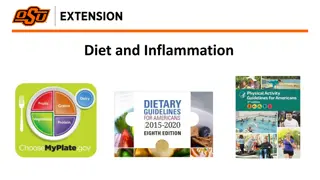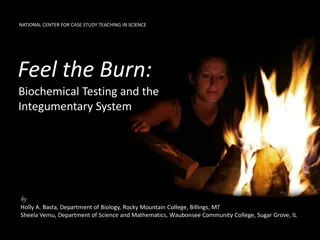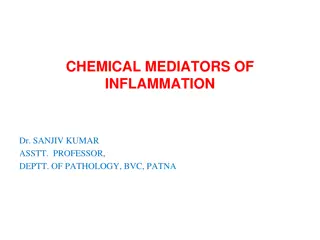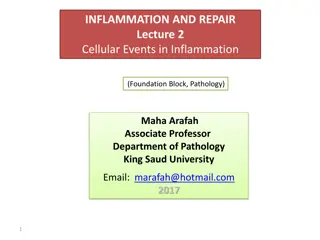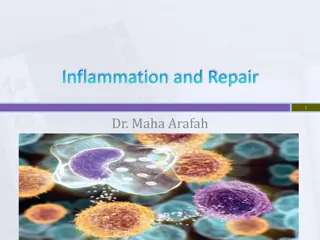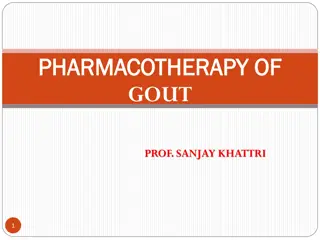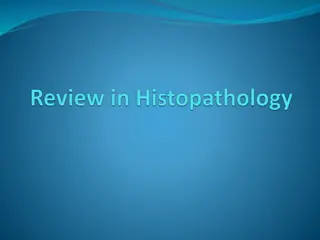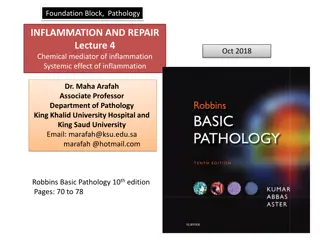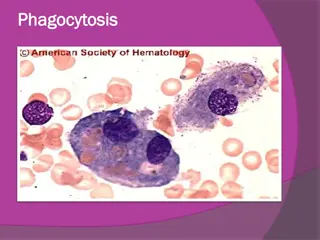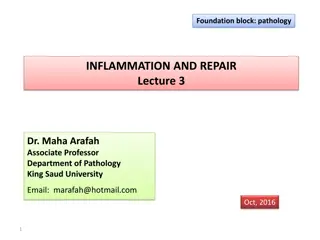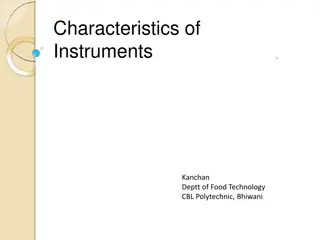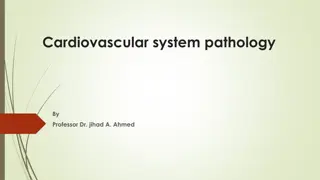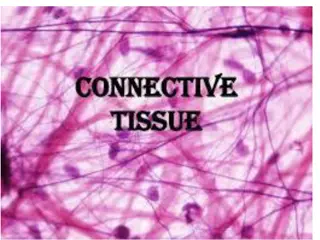Understanding Inflammation and Its Characteristics
Inflammation is the response of tissues to harmful agents, categorized as acute or chronic. Acute inflammation is rapid and short-lived, while chronic inflammation is insidious and prolonged. Chemical mediators play a crucial role in both forms, leading to tissue necrosis. The five cardinal signs of inflammation include redness, swelling, heat, pain, and loss of function, with acute inflammation exhibiting more prominent symptoms. Various stimuli trigger acute inflammatory reactions, such as infections, physical and chemical agents, tissue necrosis, foreign bodies, and immune reactions. Exudation involves the escape of fluid, proteins, and blood cells from blood vessels into the surrounding tissue, leading to altered vessel permeability.
Download Presentation

Please find below an Image/Link to download the presentation.
The content on the website is provided AS IS for your information and personal use only. It may not be sold, licensed, or shared on other websites without obtaining consent from the author. Download presentation by click this link. If you encounter any issues during the download, it is possible that the publisher has removed the file from their server.
E N D
Presentation Transcript
INFLAMMATION DR.AYSER HAMEED LEC.1
General Features Inflammation is defined as "the response of living vascularized tissues to harmful agents. Inflammation is divided into acute or chronic. The latter includes also a specific form called granulomatous inflammation.
Acute inflammation is rapid in onset (seconds or minutes), of relatively short duration (minutes, hours, or at most a few days), characterized by the exudation of fluid and plasma proteins & the emigration of leukocytes, predominantly neutrophils. Chronic inflammation in contradistinction, is of insidious onset, of longer duration, and is associated histologically with the presence of lymphocytes, macrophages, plasma cells, proliferation of blood vessels and fibroblasts.
In both forms tissue necrosis of varying extent occurs. The vascular and cellular reactions of both acute and chronic inflammation are mediated by chemical substances (chemical mediators) that are derived from plasma proteins or cells. Such substances, acting singly, in combinations, or in sequence, amplify the inflammatory response and influence its evolution.
The five cardinal signs of inflammation Are rubor (redness), tumor (swelling), calor (heat), dolor (pain), and loss of function (functio laesa). The first four signs are typically more prominent in acute inflammations than in chronic ones.
ACUTE INFLAMMATION Acute inflammatory reactions are triggered by a variety of stimuli that include:- 1. Infections: bacterial, viral, parasitic and microbial toxins. 2. Physical and chemical agents (trauma, thermal injuries, irradiation, toxins, strong acids, etc.). 3. Tissue necrosis (of any from or cause). 4. Foreign bodies (splinters, dirt, sutures). 5. Immune reactions (hypersensitivity and autoimmune reactions).
Exudation is the escape of fluid, proteins, and blood cells from the vascular system into the interstitial tissue. An exudate is an extravascular fluid that has a high protein concentration. It involves significant alteration in the normal permeability of small blood vessels in the area of injury. In contrast, a transudate is a fluid with low protein content (most of which is albumin).
It is essentially an ultrafiltrate of blood plasma that results from osmotic or hydrostatic imbalance across the vessel wall without an increase in vascular permeability. Edema refers to an excess of fluid in the interstitial tissues or body cavities; the accumulated fluid can be either an exudate or a transudate. Pus (purulent exudate) is an inflammatory exudate rich in leukocytes (mostly neutrophils), the debris of dead cells and, in many cases, microbes (pyogenic bacteria).
Acute inflammation has three major components: A. Vasodilation associated with increased blood flow. B. Increased vascular permeability associated with decreased blood flow. C. Emigration and activation of leukocytes and phagocytosis.
The major local manifestations of acute inflammation, compared to normal (1) Vascular dilation and increased blood flow (causing erythema and warmth), (2) extravasation and deposition of plasma fluid and proteins (edema), and (3) leukocyte (mainly neutrophil) emigration and accumulation in the site of injury.
A. Vasodilation and increased blood flow: This is, sometimes, preceded by a transient constriction of arterioles, lasting a few seconds. Vasodilation first involves the arterioles, which leads to an increase in blood flow; this in turn leads to opening of new capillary beds in the area with subsequent dilation of capillaries & venules.
This process allows more blood to flow into the area, a process known as active hyperemia (hyper- = increased; -emia = blood). These changes explain the clinically noted heat and redness. Vasodilation is induced by the action of several mediators (such as histamine) on vascular smooth muscles.
B. Increased Vascular Permeability and decreased blood flow: Increased vascular permeability leads to the escape of exudates into the extravascular tissue. This is driven by the increased hydrostatic pressure owing to increased blood flow through the dilated vessels and is perpetuated through the loss of proteins from the plasma that reduces the intravascular osmotic pressure and increases the osmotic pressure of the interstitial fluid. Several mechanisms have been proposed for the increased vascular permeability that includes:
1. Formation of endothelial gaps in venules due to endothelial cells contraction. This is the most common mechanism & is elicited by several mediators e.g. histamine, bradykinin, and leukotrienes. 2. Junctional retraction caused by chemical mediators such as TNF and IL-1. 3. Direct endothelial cell injury as by burns or infections. 4. Leukocyte-dependant injury due to accumulation of leukocytes and their activation products (such as toxic oxygen radicals and proteolytic enzymes) during the inflammatory response.
C. Emigration and activation of leukocytes and phagocytosis. The journey of leukocytes from the vessels lumen to the interstitial tissue is called extravasation. This can be divided into the following steps:
1. Binding of leukocytes to the endothelial cells. Normally, the vascular endothelium does not bind circulating cells or impede their passage. In inflammation, however, the endothelium becomes activated to permit binding of leukocytes to its surface. This is followed by. 2. Transmigration of leukocytes across the endothelium (diapedesis). 3. Migration of leukocytes within the interstitial tissues toward the focus of tissue injury.
Because blood flow slows down in inflammation, more white cells assume a peripheral position along the endothelial surface. This process is called margination. Subsequently, leukocytes tumble and roll over slowly along the endothelium and eventually come to rest through firm adhesions with the endothelial cells. In time, the endothelium becomes virtually lined by white cells, an appearance called pavementing. After firm adhesion, leukocytes insert pseudopods into the junctions between the endothelial cells, squeeze through interendothelial junctions, and eventually, traverse the basement membrane and escape into the extravascular space.
Leukocyte adhesion and transmigration are achieved by the binding of complementary adhesion molecules on the leukocyte and endothelial surfaces, a process regulated by chemical mediators. The next step in the process is migration of the leukocytes through the endothelium, called transmigration or diapedesis.
Chemokines (chemoattractants) act on the adherent leukocytes and stimulate the cells to migrate toward the site of injury or infection. Leukocyte diapedesis, similar to increased vascular permeability, occurs predominantly in the venules. After traversing the endothelium, leukocytes eventually pierce the basement membrane, probably by secreting degrading enzymes such as collagenases & elastases.
Once leukocytes enter the extravascular connective tissue, they are able to adhere to the extracellular matrix by virtue of integrins and CD44. Thus, the leukocytes are retained at the site where they are needed. Chemotaxis Both exogenous and endogenous substances can act as chemoattractants. The former is exemplified by bacterial products.
Endogenous chemoattractants, however, include several chemical mediators: 1. Components of the complement system, particularly C5a. 2. Products of the lipoxygenase pathway, mainly leukotriene B4 (LTB4). 3. Cytokines (secreted from cells) e.g., IL-8.
Leukocyte Activation This refers to induction of a number of responses within leukocytes, which are mediated by:- Microbes. Products of necrotic cells. Antigen-antibody complexes. and cytokines.
Phagocytosis Phagocytosis is one of the major functions of the accumulated neutrophils and macrophages at the inflammatory focus, being responsible for eliminating the injurious agents. Phagocytosis involves three distinct but interrelated steps: 1. Recognition and attachment of the particle to be ingested by the leukocyte. 2. Its engulfment, with subsequent formation of a phagocytic vacuole. 3. Killing and degradation of the ingested material.
Recognition and Attachment Although neutrophils and macrophages can engulf bacteria without attachment to specific receptors, typically the phagocytosis of microbes and dead cells is initiated by recognition of these particles by receptors expressed on the leukocyte surface.
The efficiency of phagocytosis is greatly enhanced when microbes are opsonized by specific proteins (opsonins) for which the phagocytes express high-affinity receptors. The major opsonins are IgG antibodies, the C3b breakdown product of complement, and certain plasma lectins.






